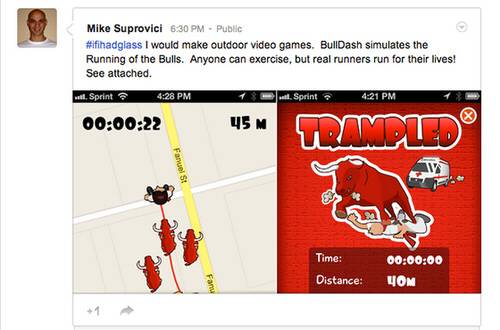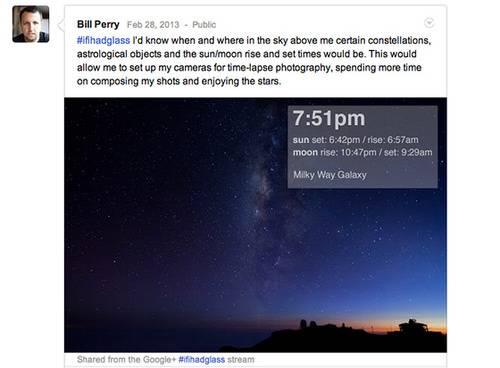
Google Glass is coming. Sure, the early adopters will be viewed as weirdos and the idea of a tiny head-mounted camera raises all kinds of creepy privacy questions, but Glass is cool.
Google’s first iteration may or may not be a slam dunk, but wearable computing is unquestionably the next big thing, and heads-up displays are going to be a part of our future, once everybody gets over the dorky stigma.
To get the ideas flowing (and promote its upcoming product launch), Google asked its users to propose use cases for Glass and hashtag them #ifihadglass. The campaign, which wrapped up last week, yielded some snarky — and, of course, some truly dumb — responses, but there are plenty of smart suggestions, each of which lets us envision the type of techno-utopian sci-fi future Sergey Brin dreams about every night.
Yes, it will be awkward the first time one of your friends shows up to the bar wearing a computer on their face. That’s not what Glass is for, at least not initially. In general, people seem to be most excited about what Glass will mean for education, medicine, communicating, gaming and getting around.
1. Enhancing Surgery With Augmented Reality

A number of the #ifihadglass contest respondents talked about how the technology could be use by surgeons as virtual assistants in the operating room. Timothy Lee, a surgical resident at New York University, proposes using Glass to record operations for teaching purposes, enable remote assistance via livestream and show the surgeon vitals, CT scan and other pertinent medical information.
By tapping into real-time data, reference material and input from live surgeons across the globe, devices like Glass could reduce the number of errors made during surgery. Here’s hoping the voice recognition is spot on.
2. Revolutionizing Higher Education
A great deal of the excitement about Glass is coming from people working in higher education, as well as from students. Ben Foster, a professor at DePaul University, is one of many academics that are eager to augment the teaching experience with Google Glass, pulling up pertinent data without turning his back to students, for example.
For students, Google Glass could be transformative. Some are even talking about how Glass could potentially aid those with learning disabilities. Recording lectures, live streaming them for remote access, audio-note taking and supplementing lectures with related data are just the beginning. Of course, exactly how Glass is used (and how useful it is) will vary depending on the curriculum.
3. Enhancing Less Formal, More Hands-On Learning
While universities and colleges will be among Glass’s earliest adopters, the advantages are not limited to formal education. Just like people post tutorial videos to YouTube, a camera-equipped camera you wear on your face opens up new possibilities for teaching people things from a hands-on, first person perspective. Fixing things, cooking meals, learning to play the guitar. Anything you use your hands for can be taught (and augmented with relevant details) via a Hangout or YouTube video.
4. Augmented Reality Gaming

This is one of the use cases people seem most excited about. And for good reason: Wearable computing and augmented reality open up new doors when it comes to gaming, which is already huge on smartphones and tablets. With technology like Glass, game developers can overlay gameplay over the real world, and plenty of them are already thinking about how to take their Android games to this new, exciting (or creepy) level.
5. Overcoming Disabilities
Okay, so Google Glass won’t cure blindness, but the technology can be quite valuable to those with certain visual, auditory and physical handicaps. At the University of New Brunswick Libraries, Jeff Carter wants to use Glass to make things more accessible to the visually impaired via real-time optical character recognition and text-to-speech translation.
Navigating the stacks would be a lot easier (for everybody, really) with digital signage overlaying the physical world. Indeed, for the visually impaired, navigating just about anywhere could be made much easier thanks to Glass’s augmented reality maps and voice control.
At Shriner’s Hospital For Children in Portland, the assistive technology team is already brainstorming ways that Glass could be used to “unlock their learning potential and access their world.”
6. Stargazing

No, I don’t mean surreptitiously snapping photos of Nikki Minaj at the grocery store (although I’m sure they’ll be plenty of that sort of thing). Amateur astronomers will be able to look at the sky with a whole new layer of digital insight using tiny, face-mounted computers.
Mobile astronomy apps have been popular on smartphone users for years, and for good reason. It’s pretty neat to hold your phone up to the sky and see information about planets, constellations, galaxies and the like. Now imagine that experience without the smartphone, overlaid directly over what you’re seeing.
7. Healthier Living
There are all kinds of ideas being thrown around about how Glass could help people better manage their health. First, there’s the somewhat obvious example of porting already-popular fitness tracking apps like RunKeeper over to Glass for a more seamless experience. Many of things runners and fitness buffs use their smartphones for now could be simplified by Glass. If nothing else, displaying real-time stats about your run in front of you as you go could be a serious motivator. Also, the bone conduction audio makes headphones unnecessary and reduces the odds of you getting hit by a truck.
If Santa Clara University student Alexander Vincent Molloy has his way, you’ll also be able to return health-related information about foods while you’re cooking or even shopping. Using Google Goggles-style image recognition and search, a Glass app could do exactly that, helping the health-conscious make smarter decisions without fiddling with their phones as much.
8. Reconnecting With History
One of the most delightfully nerdy Glass use cases being talked about is augmented reality historical tours and museum exhibits. Again, just imagine some of the work that’s been done with smartphone apps and remove the phone from the equation (or at least the act of taking it out and holding it up).
Armed with Glass-supported Android apps, walking through the historical Old City District of Philadelphia or the history-rich parks of Massachusetts could be like taking one of those audio-guided tours on digital steroids. Even if an app is not built specifically to overlay data and imagery on top of historical buildings, the ability to do a quick, relevant voice search without pulling out your phone will make learning about history more immersive than ever.
9. Augmented Reality Art

Like historical tours, the experience of viewing art could be enhanced using augmented reality. Some will undoubtedly balk at the idea of wearing a face computer to the MoMA. Why not just enjoy the art and leave gadgets out of it? Because there’s way more information in the world about a given painting, sculpture or design than could ever fit into an exhibit.
It doesn’t have to bound by museum walls, either. European design agency Nuelandherzer says it would use Glass to create an augmented reality experience for viewing and learning about urban street art around the world.
10. Real-Time Language Translation

Previously the pipe dream of optimistic futurists, real-time language translation is a reality today (even if its accuracy could use a little more polish). Using technology Google already owns (OCR and Google Translate), Glass could translate foreign signs and menus. Even more compelling is the device’s theoretical ability to translate spoken language into real-time subtitles, effectively eliminating any language barrier between two Glass-wearing individuals. Lots of people are thinking about how learning and using sign language could change too. Pretty powerful stuff.

















